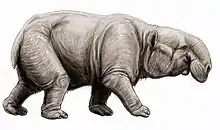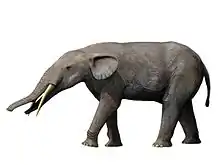Phosphatherium
Phosphatherium escuillei is a basal proboscidean that lived from the Late Paleocene to the early stages of the Ypresian age[2] until the early Thanetian some 56 million years ago in North Africa. Research has suggested that Phosphatherium existed during the Eocene period.[3]
| Phosphatherium | |
|---|---|
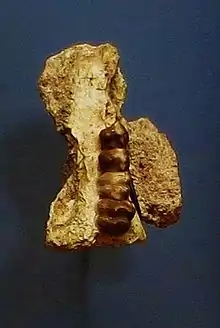 | |
| Fossil | |
| Scientific classification | |
| Domain: | Eukaryota |
| Kingdom: | Animalia |
| Phylum: | Chordata |
| Class: | Mammalia |
| Order: | Proboscidea |
| Family: | †Numidotheriidae |
| Genus: | †Phosphatherium Gheerbrant, Sudre & Cappetta, 1996[1] |
| Species: | †P. escuillei |
| Binomial name | |
| †Phosphatherium escuillei Gheerbrant, Sudre & Cappetta, 1996[1] | |
Description
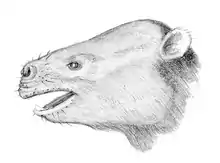
P. escuillei possessed rather flat features, centered around a low skull and a long, straight dorsal profile. The skull itself was rather disproportionate, consisting of an elongated cranial region and a rather short rostrum.[4] The sagittal crest, the ridge along the dorsomedian line of its skull, spans across nearly half of the skull itself. The nasal cavity is high and wide, suggesting a large snout in life.[4][5]
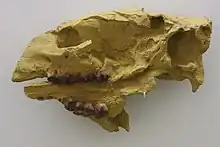
One of the main factors of Phosphatherium's body is its nontraditional musculoskeletal system. The shape of its head is composed of attributes of a snout, more vividly, turning into a mouth with a rounded jawline. Similar mammals in its order retained a more snout-like nose, which was also a factor that pertained to it having a semiaquatic lifestyle. Furthermore, sexual dimorphism can be noticed on Phosphatherium's face by a varying degrees of muscle attachments on its upper jaw.[6]
Phosphatherium lacked a trunk. The tooth rows extend back to roughly 45% of its total skull length. The dental structures suggests that P. escuillei is a heterodont, meaning it possessed more than one type of tooth morphology.[7] This is evident because they possessed more than one type of molar upon fossil examinations. The various dental formations of heterodonts suggest that this animal, unlike later proboscideans, may have been omnivorous.[8]
The unique traits of Phosphatherium teeth suggest them to be intraspecific. Some features of P. escuilliei's teeth and jaw structures also show noticeable variation, which is related to sexual dimorphism. This suggests physiological differences existed between males and females, which ultimately suggest behavioral differences.[9]
The lower jaw reached a length of 10 cm and had a rather low body. The number of teeth was somewhat reduced compared to older proboscideans. Adult animals had the following dental formula:
| Dentition |
|---|
| 3.1.4.3 |
| 2.1.3.3 |
The tooth row extended over a length of 8 cm, taking up less than half of the skull length. In the upper jaw, the second incisor (I2) was enlarged and conical in shape, but was perpendicular to the bone. In the lower jaw, on the other hand, the first incisor (I1) showed clear enlargements. However, both teeth did not yet form true tusks. The anterior dentition did not show a closed row of teeth, in the upper jaw there was an additional small diastema behind the first premolar. The premolars as a whole were quite simply built and not very molarised, i.e. they hardly resembled the molar. These had a bilophodont structure with two clearly formed transverse enamel ridges. The rearmost molar of the mandible, however, had a third enamel bar. In general, the teeth were brachyodont.[1][9]
Discovery

The first finds were probably made by a fossil dealer in the early 1990s from an unknown location. The two fragments of the upper jaw were coated with phosphate, and the preparation of the finds revealed the tooth of a fossil shark, which dates to the late Paleocene (Thanetian) and thus confirms the ancient age of the finds. The holotype (copy number MNHN PM2) consists of a right upper part of the jaw with the last two premolars and the first two molars (P3 to M2). It is now in the Muséum National d'Histoire Naturelle in Paris. The first scientific description took place in 1996 by Emmanuel Gheerbrant and colleagues. The name Phosphatherium is made up of the Greek words φωςφορος (phosphoros "light-bearing") and θηρίον ( thērion "animal") and refers to the fact that it is stored in phosphate-containing sediments. The only known species is Phosphatherium escuilliei. The species name escuilliei honors the person who found the type fossils, François Escuillié. The first description was largely limited to the tooth features, a more extensive template of the then known find material was only published two years later.[1]
The first fossil finds were discovered in the north-eastern part of the Ouled Abdoun Basin in a phosphate-containing layer. However, they only comprised two fragmented upper jaws. However, the exact location of this find was not known. Further and much more extensive finds were discovered in the early 2000s in the same basin in the Grand Daoui area. This consists of numerous skull fragments, mandibles and some limb elements.[9][10] Other very early proboscideans are known from the same area, the related Eritherium and Daouitherium.[11]
Taxonomy
Phosphatherium is known primarily from two maxilla fragments dated to the latest Paleocene deposits of the Ouled Abdoun Basin, Morocco, which date from the Thanetian epoch. It is one of the oldest[12] and smallest members of the Proboscidea, with an estimated shoulder height of about 30 centimetres (12 in) and body mass of 17 kilograms (37 lb).[13] Like its later relative, Moeritherium, the animal was probably an amphibious browser that fed on aquatic plants, akin to a very small tapir. Both animals are included in the family Numidotheriidae, together with Numidotherium.
Below is a phylogenetic tree based on Tabuce et al. 2019.[14]
| Proboscidea |
| |||||||||||||||||||||||||||||||||||||||||||||||||||||||||
Palaeobiology
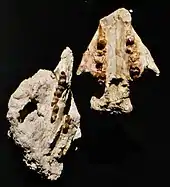
Phosphatherium is thought to have had a broad diet. The dental microwear patterns observed on their teeth show lengthy scratches on the molars of juveniles. Correspondingly, similar patterns are found on adult individuals. Through study of the wear and specifically scratches on the teeth of Phosphatherium, the food items it ingested include shrubs and bushes, indicating a mixed feeding preference. Adult molars are found to have a much higher density of scratches, indicating abrasive food sources and possibly insects and small animals. Overall, Phosphatherium is thought to be an omnivorous browser mainly determined by its preferences, as well as the availability of resources.[15]
Considering its highly adapted folivorous jaw and tooth structure, Phosphatherium provides evidence of the high age of African endemism. The dental structure of Phosphatherium suggests its diet consisted mainly of leaves, which indicates it may have fulfilled a niche role in its environment, although diet can only be inferred. The discovery of this animal has ultimately helped reinforce the African origin of proboscideans, and provide insight into the radiation of modern orders of placental mammals.[10]
References
- Gheerbrant, E.; Sudre, J.; Cappetta, H. (1996). "A Palaeocene proboscidean from Morocco". Nature. 383 (6595): 68–71. Bibcode:1996Natur.383...68G. doi:10.1038/383068a0. S2CID 4362199.
- http://www3.planetarioroma.it/content/download/4908/62991/file/637_638.pdf. Archived 2016-03-05 at the Wayback Machine
- Seiffert, Erik R. (2007). "A new estimate of afrotherian phylogeny based on simultaneous analysis of genomic, morphological, and fossil evidence". BMC Evolutionary Biology. 7: 224. doi:10.1186/1471-2148-7-224. PMC 2248600. PMID 17999766.
- Gheerbrant, E; Amaghzaz, M; Bouya, B; Goussard, F; Letenneur, C (2014). "Ocepeia (Middle Paleocene of Morocco): the oldest skull of an afrotherian mammal". PLOS ONE. 9 (2): e89739. Bibcode:2014PLoSO...989739G. doi:10.1371/journal.pone.0089739. PMC 3935939. PMID 24587000.
- Ferretti, Marco; Debruyne, Regis (2010). "Anatomy and Phylogenetic Value of the Mandibular and Coronoid Canals and Their Associated Foramina in Proboscideans (Mammalia)". Zoological Journal of the Linnean Society. 161 (2): 391–413. doi:10.1111/j.1096-3642.2010.00637.x.
- Gheerbrant, Emmanuel; Sudre, Jean; Tassy, Pascal; Amaghzaz, Mbarek; Bouya, Baâdy; Iarochène, Mohamed (2005). "Nouvelles données sur Phosphatherium escuilliei (Mammalia, Proboscidea) de l'Eocene inférieur du Maroc, apports à la phylogeny of the Proboscidea et the ongulés lophodontes". Geodiversitas. 27 (2): 239–333.
- https://www.app.pan.pl/archive/published/app47/app47-493.pdf
- "Archived copy" (PDF). Archived from the original (PDF) on 2014-10-24. Retrieved 2014-10-23.
{{cite web}}: CS1 maint: archived copy as title (link) - Gheerbrant, E. ( 1 ), et al. "New Data On Phosphatherium Escuilliei (Mammalia, Proboscidea) From The Early Eocene Of Morocco, And Its Impact On The Phylogeny Of Proboscidea And Lophodont Ungulates." Geodiversitas 27.2 (2005): 239-333.
- Gheerbrant, Emmanuel (1998). "The Oldest Known Proboscidean and the Role of Africa in the Radiation of Modem Orders of Placentals". Bulletin of the Geological Society of Denmark. 44: 181–85. doi:10.37570/bgsd-1998-44-12.
- Gheerbrant, E.; Sudre, J.; Cappetta, H.; Iarochène, M.; Amaghzaz, M.; Bouya, B. (2002). "A new large mammal from the Ypresian of Morocco: Evidence of surprising diversity of early proboscideans" (PDF). Acta Palaeontologica Polonica. 47 (3): 493–506.
- Gheerbrant, Emmanuel; Sudre, Jean; Cappetta, Henri; Mourer-Chauviré, Cécile; Bourdon, Estelle; Iarochene, Mohamed; Amaghzaz, Mbarek; Bouya, Baâdi (2003). "The mammal localities of Grand Daoui Quarries, Ouled Abdoun Basin, Morocco, Ypresian : A first survey" (PDF). Bulletin de la Société Géologique de France. 174 (3): 279–293. doi:10.2113/174.3.279.
- Larramendi, A. (2016). "Shoulder height, body mass and shape of proboscideans" (PDF). Acta Palaeontologica Polonica. 61. doi:10.4202/app.00136.2014.
- Rodolphe Tabuce, Raphaël Sarr, Sylvain Adnet, Renaud Lebrun, Fabrice Lihoreau, Jeremy E. Martin, Bernard Sambou, Mustapha Thiam and Lionel Hautier; 2019 "Filling a gap in the proboscidean fossil record: a new genus from the Lutetian of Senegal." Journal of Paleontology. doi:10.1017/jpa.2019.98
- Calandra, Ivan; Göhlich, Ursula B.; Merceron, Gildas (2010). "Feeding preferences of Gomphotherium subtapiroideum (Proboscidea, Mammalia) from the Miocene of Sandelzhausen (Northern Alpine Foreland Basin, southern Germany) through life and geological time: evidence from dental microwear analysis". Paläontologische Zeitschrift. 84: 205–215. doi:10.1007/s12542-010-0054-0. S2CID 56260944.
- Gheerbrant, Emmanuel; Sudre, Jean; Cappetta, Henri; Bignot, Gérard (January 1998). "Phosphatherium escuillieidu Thanétien du Bassin des Ouled Abdoun (Maroc), plus ancien proboscidien (Mammalia) d'Afrique". Geobios. 31 (2): 247–269. Bibcode:1998Geobi..31..247G. doi:10.1016/S0016-6995(98)80041-7.
http://mygeologypage.ucdavis.edu/cowen/historyoflife/Phosphatherium.html
